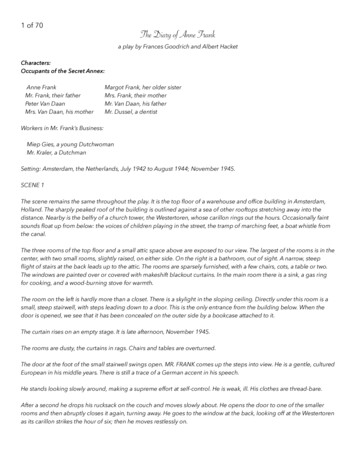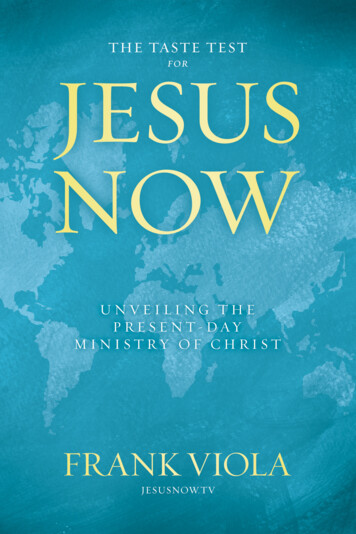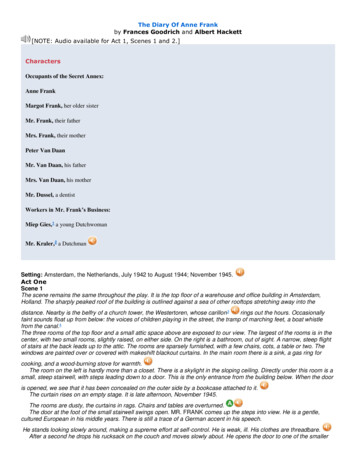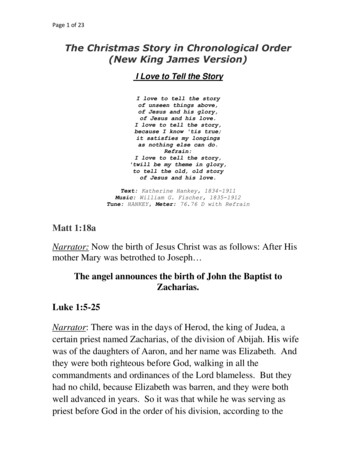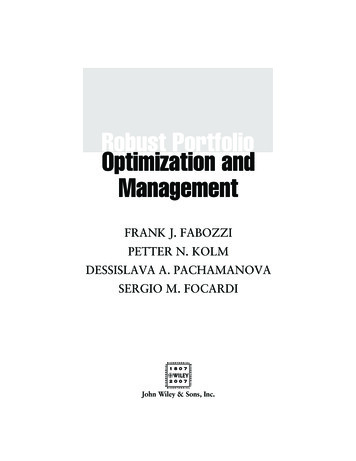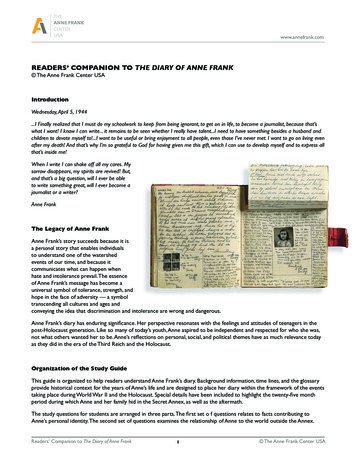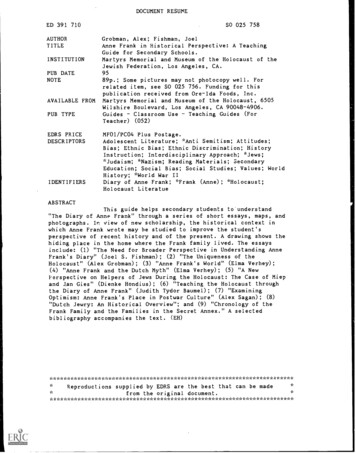
Transcription
IntroductionThe Jesus StoryA c c o r d i n g to e s t i m at e s , a p p r ox i m at e ly 1.25 b i l l i o n C h r i s t i a n slive in the world today. Many, if not most, have become overly familiarwith their Bibles. The same can be said about how they view the LordJesus Christ.A daring statement, you say? Perhaps. How can the two of us thinkthat Christianity has become overfamiliar with the most influential person who ever lived, the most important person who ever walked planetEarth?As you read this book, we hope you will come to the same conclusion.Better still, when you finish, we expect you will encounter the Scripturesin a fresh way. And as a result, you will encounter your Lord anew as well.Let’s face it. The Bible is often viewed as a disjointed array of stories, events, laws, propositions, truths, ethical statements, and morallessons.But as we will demonstrate in this book, the sixty-six books of theBible are woven together by a single storyline. One of the best ways tolook at the twenty-seven books of the New Testament may be to seeix00-01 Jesus Theography FP.indd 98/2/12 8:48 AM
Introductionthem as a commentary on the Old Testament. The entire Scriptures,both Old and New Testaments, are unified by a common narrative.And once our eyes are opened to see that narrative, everything in bothTestaments gels into a coherent, understandable, and amazing story.And what is that story? Well, it’s not enough to call it “salvation history” as many people do.1No. It’s the story of Jesus Christ.2The end product of biblical Christianity is a person—not a book,not a building, not a set of principles or a system of ethics—but oneperson in two natures (divine/human) with four ministries (prophet/priest/king/sage) and four biographies (the Gospels). But those fourbiographies don’t tell the whole story. Every bit of Scripture is part ofthe same great story of that one person and that one story’s plotline ofcreation, revelation, redemption, and consummation.Toward a New Kind of BiographyWriting about Jesus is like matrimony: not to be entered into unprepared or lightly, but reverently, discreetly, advisedly, soberly, and in aweof God. Not to mention that over the last fifty years, there have beencountless books telling, retelling, and reconstructing the life of Jesus ofNazareth.3 In fact, there are more biographies of Jesus than of any otherhuman—one hundred thousand biographies in English alone.4So why this book?First, this isn’t a biography. It’s a theography. Even if you argue thata biography of Jesus is possible, which is hotly debated among scholars today,5 we are telling the story of God’s interactions, intersections,and interventions with humanity through the life of Jesus. We are lessconcerned with every fact and detail of Jesus’ life than we are about thenarratives, metaphors, signs, and symbols that reveal pictures of God’stouching of humanity through the person and identity of Jesus. In eachmajor scene in the Jesus story, we try to provide “snapshots”—organicfreeze-frames and visual markers of Jesus in living color and surroundsound to be experienced, breathed, and lived by our readers.This book lifts up the epic story of Jesus as the single, ascertainablex00-01 Jesus Theography FP.indd 108/2/12 8:48 AM
The Jesus Storytruth that triumphs over all other contingent truths. In other words,human identity is bound up with the story of an individual and thestory of a community. In a world that tries to snatch an identity off theracks of an Armani store, or from the marble floor of a BMW showroom, we believe that humanity was created to find its identity in arelationship with God. The story of Jesus as found in the Bible showsus how to do that. Neither of us wants to bend the world to see thingsthrough our eyes. But we do want to entice the world to see thingsthrough Jesus’ eyes.Virtually every biography of Jesus begins with the nativity accountin Bethlehem.6 The Jesus theography you hold in your hands begins thestory of Jesus at “the beginning.”7From Eternity Past to the Second ComingAccording to Scripture, the Jesus story doesn’t begin in Bethlehem orNazareth. It begins in eternity past, when the Word ( Jesus in His preincarnate state) “was with God, and . . . was God.”8 So we will tell theJesus story, not “from the womb to the tomb,” but from eternity past(as the preexistent Son) to His second coming (as the postresurrected,risen Lord).9In addition, we will rehearse the story of Jesus—the greatest storyever told—by following the plotline that stretches from Genesis toRevelation. And we will demonstrate that all the Scriptures are heldtogether by a single narrative: the story of Jesus Christ.10The name Jesus refers to the incarnate Christ who had a humannature. As such, the name Jesus doesn’t appear in Genesis or elsewherein the Old Testament. But that doesn’t mean He wasn’t present as thepreexistent Son through whom, by whom, and to whom all things werecreated.11 So in this book, we will use the terms Jesus, Christ, and Son of Godinterchangeably in a nontechnical way.12 They all refer to the same person.As far as we know, there is no biography of Jesus that tells His storyfrom Genesis to Revelation. If this is correct, one may ask, “Why hasn’ta book like this been written before?” The reason is simple. Biographiesof Jesus have generally been written by those trying to investigate thexi00-01 Jesus Theography FP.indd 118/2/12 8:48 AM
Introductionhistorical Jesus. In general, such people aren’t interested in looking atJesus in the entire biblical canon. On the flip side, those interested intracing the biblical narrative from Genesis to Revelation are typicallydisinterested in historical Jesus studies. So these two approaches haveyet to converge.13That’s where this book comes in. It brings together historical Jesusstudies with a survey of the entire biblical canon.14 In so doing, it seeksto reclaim the Jesus-shaped narrative of Scripture.15The Core NarrativeIn many Christians’ minds, the Old and New Testaments are two separate entities. Melito (second century) and Tertullian (third century)were the first to call the two halves of the Bible the Old Testament andNew Testament.16 However, the Old Testament and the New Testamentbelong to the same inspired canon. Thus they are organically united.To underscore this unity, we will be calling the Old Testament the FirstTestament and the New Testament the Second Testament throughoutthis book.In our experience and observation, countless evangelical, postevangelical, Reformed, charismatic, and mainline Christians are not awarethat the main subject of the entire First Testament is Jesus Christ. Butconsider what Jesus Himself said about the Scriptures: “You search theScriptures because you think they give you eternal life. But the Scripturespoint to me!”17It is for this reason that statements such as “according to the prophets,”“as it is written,” “according to the Scriptures,” “that the Scripture mightbe fulfilled,” and “in all the Scriptures” are peppered throughout the entireSecond Testament. What is more, the Second Testament authors consistently interpreted the First Testament writings in the light of Christ.18Many believe that the Second Testament writers simply used partsof the First Testament as proof texts to show that Jesus of Nazarethwas the promised Messiah of Israel and Lord of the world. But this isnot the case.19The Second Testament writers consistently quoted or cited largexii00-01 Jesus Theography FP.indd 128/2/12 8:48 AM
The Jesus Storysections of the First Testament, using them to unfold the Jesus story.20But that’s not all. The Second Testament authors used the same FirstTestament texts independently of one another. And they interpretedthem in exactly the same way, often citing the texts in the same order.21This fact alone demonstrates that the Second Testament authorsshared a common method of interpreting the First Testament. Thequestions emerge, then: Where did they find this method of interpretation?What was their common source?The answer is that Jesus Himself was the common source.22Jesus Revealed Through the ScripturesThe Gospels tell us that Jesus took His followers through the Scripturesand gave them a divinely inspired hermeneutic (method of interpretation) by which to understand the First Testament. In turn, the Lord’soriginal disciples passed this interpretative key to those whom theyinfluenced (this would include people such as Mark, Paul, and Luke).Luke suggested this in his gospel when he rehearsed Jesus’ encounter with two disciples on the road to Emmaus:Then beginning with Moses and with all the prophets, He explainedto them the things concerning Himself in all the Scriptures.23Note the words “all the Scriptures.” This includes the First Testament—Genesis through Malachi. They said to one another, “Were not ourhearts burning within us while He was speaking to us on the road,while He was explaining the Scriptures to us?”24 Luke went on to saythat Jesus opened the Scriptures to His disciples: “Now He said to them,‘These are My words which I spoke to you while I was still with you,that all things which are written about Me in the Law of Moses and theProphets and the Psalms must be fulfilled.’ Then He opened their mindsto understand the Scriptures.”25In this passage, Jesus unveils Himself through the three parts of theHebrew Bible: (1) the law of Moses (the Torah); (2) the Prophets (theNevi’im); and (3) the Psalms, which represent the Writings (the Ketuvim).xiii00-01 Jesus Theography FP.indd 138/2/12 8:48 AM
IntroductionThese three sections make up the Tanakh—the rabbinic name for theHebrew Bible.26 The way the Second Testament authors quoted the FirstTestament forms a pattern—a shared hermeneutic for understanding theFirst Testament.It is easy to see, then, that the source of this common hermeneutic wasJesus Himself. Jesus taught His disciples how to understand the HebrewScriptures, and this is reflected throughout the Second Testament.27Jesus’ use of the First Testament text was revolutionary for His time. AsR. T. France points out, Jesus “applied the Old Testament in a way that wasquite unparalleled. The essence of his new application was that he saw thefulfillment of the predictions and foreshadowings of the Old Testamentin himself and his work.”28 The early Christian church “was founded onthis distinctive and revolutionary use of the Old Testament”29—a usagethat was handed down to the apostles by Jesus Himself. Jesus clearly saidthat He was the fulfillment of the entire Hebrew Bible (represented by theTorah, the Writings, and the Prophets).30If you believed Moses, you would believe Me; for he wrote about Me.31Do not think that I came to destroy the Law or the Prophets. I did notcome to destroy but to fulfill.32Consider this question with these texts in mind: If you were to askJesus what the Scriptures were about, what would His answer be?33R. T. France comments, “Jesus saw his mission as the fulfillment ofthe Old Testament Scriptures; not just of those which predicted a coming redeemer, but of the whole sweep of Old Testament ideas.”34 In thisregard, Jesus not only completes the First Testament story; He fulfills it.But fulfilling doesn’t happen only in view of the accomplishment of itspromises. As you will discover in this book, Jesus actually embodies theFirst Testament. He “fills full” the ancient Text.35In a word, Jesus is the thread that holds all Scripture together. Heis the prism that breaks forth its multifaceted colors. He is the lens thatputs all of it into focus, the switch that sheds light on its dimly lit quarters, and the key that unlocks its meaning and richness.36xiv00-01 Jesus Theography FP.indd 148/2/12 8:48 AM
The Jesus StoryWe agree with a long tradition of theologians who do not viewthe Scriptures as a storehouse of propositions on every imaginable subject but instead discover the place from which the Spirit of God makesChrist known.37 Or as Protestant Reformer Martin Luther has put in epigrammatic fashion: “Scripture is the cradle in which Christ lies.”38 ScotMcKnight puts it in more current form: “We have to become a People ofthe Story . . . we need to immerse ourselves even more into the Story ofJesus. The gospel is that the Story of Israel comes to its definitive completeness in the Story of Jesus, and this means we have to become Peopleof the Story-that-is-complete-in-Jesus.”39Our desire is to tell that story.Reading Scripture as a WholeGiven what we have established so far, the approach we are taking to theScriptures is both holistic as well as reductionist. It is reductionist in thatwe are drawing from the best findings of modern historical research.40Yet it’s holistic in that we are bringing the First Testament stories,events, and accounts into the core narrative of Jesus—just as the SecondTestament writers did when they interpreted the First Testament.41 Weare searching for the story the Gospels tell about Jesus in the story foundin the First Testament.The Bible didn’t emerge out of a vacuum. It is a historical but alsometaphorical and narrative story of truth written within history. Thus,history matters in our interpretation of the biblical text. At the sametime, the Bible is a collection of writings that are tied together by acommon theme. Therefore, the interweaving of both Testaments alsomatters in our interpretation of the biblical text.To use a metaphor, we are not only inspecting each tree in the forest (the reductionist approach) but also stepping away from the treesto view the entire landscape at high altitude, making note of how eachtree connects with the others in an ecosystem (the holistic approach).42And further, we reveal how we see that forest as nourishing, creative,life-giving, revelatory, and beautiful.To put it another way, the Bible contains its own hermeneutic.43 Asxv00-01 Jesus Theography FP.indd 158/2/12 8:48 AM
Introductionusual, Augustine has put it best: “In the Old Testament, the New is concealed; in the New, the Old is revealed.”44 This being so, the Holy Spiritoften had an intention in Scripture that went beyond its authors’ presentknowledge.45Understanding the author’s intent in a given portion of Scriptureis certainly part of the task of biblical interpretation. But it’s notthe whole task. As you read this book, this fact will become abundantly clear. The Second Testament authors “remain true to the mainintention” of the First Testament authors.46 But they go beyond thatintention to the Spirit-inspired meaning found in Christ.47In our theographical snapshots, we will be employing the samemethod of interpretation that the Second Testament writers used intheir interpretation of the First Testament—a method given to themby Jesus Himself. This method of interpretation safeguards us fromentertaining subjective, fanciful, and forced allegorical interpretationson the one hand48 and completely missing Christ in the sacred Text onthe other.49Again, the Scriptures are not a library of disjointed, independent,inspired books. The First and Second Testaments are not two separatebooks bound together between a single cover. Rather, they are a unifiedcanon. All the books of that canon contribute to the plotline of God’scovenantal relationship with humanity through Jesus. You can think ofthe First and Second Testaments as act 1 and act 2 of the same drama.Each book, therefore, must be understood and interpreted within theframework of the greater whole.50Jesus Christ is the glue that binds both Testaments together. AsBrevard Childs says, “The completely New of the gospel is formulatedin terms of the Old. Herein lies the deep mystery surrounding the twotestaments. Separate and yet undivided, two voices yet the sound issimilar, an Old Word pointing to the New, yet the New is only knownin the Old.”51That said, it’s a profound mistake to detach Scripture—both Firstand Second Testaments—from Christ.52 The Bible has no real meaningunless it is grounded in Christ.53 The beauty of Scripture for followersof Jesus is to reveal Christ.xvi00-01 Jesus Theography FP.indd 168/2/12 8:48 AM
The Jesus StoryThe Witness of the SecondTestament AuthorsHere are just a few samples of how the authors of the Second Testamentread the First Testament in the light of Christ:Matthew quoted Hosea about a prophecy concerning Israel: “Outof Egypt I called My Son.”54 But Matthew located its fulfillment in Jesus.He drew similar connections throughout his gospel.55John informed us that Philip declared Jesus to be the fulfillmentof the Law and the Prophets: “We have found Him of whom Mosesin the law, and also the prophets, wrote—Jesus of Nazareth, the son ofJoseph.”56John applied words from Isaiah to Jesus, equating Christ with “thearm of the L o r d .”57 John’s gospel is full of references showing howJesus fulfills the images and events of the First Testament and of theJewish messianic expectation.58According to Paul, one cannot understand the First Testament exceptin Christ. Jesus is the key that unlocks its meaning.59 Three quick examples:1. Paul stated that Adam is an image, or a model, of Jesus.602. Paul argued that Israel’s festivals and food laws are embodied inChrist. They are mere shadows that point to Jesus, the reality.613. Paul said the rock that followed Israel represents Christ.62Paul’s epistles are rife with these kinds of connections.The writer of Hebrews took a promise that God gave to King Davidand applied it to Jesus.63 He also stated that the Law foreshadowed whatwas in the new covenant: namely, Jesus Christ.64 This is a major themethroughout the book of Hebrews.According to Peter, the prophets spoke of the sufferings and gloriesof Christ in ways that they themselves didn’t fully understand.65 Peterapplied the words of Isaiah about a stone lying in Zion to Jesus.66In like manner, the church fathers, the Reformers, and countlesstheologians and scholars of the past and present all testify to this sameunderstanding of the First Testament. With a united voice, they declaredxvii00-01 Jesus Theography FP.indd 178/2/12 8:48 AM
Introductionthat Jesus is the interpretative key of the Bible. (In the appendix, we givea sampling of these post-apostolic witnesses.)To put it in a sentence:In Jesus the promise is confirmed, the covenant is renewed, the prophecies are fulfilled, the law is vindicated, salvation is brought near,sacred history has reached its climax, the perfect sacrifice has beenoffered and accepted, the high priest over the household of God hastaken his seat at God’s right hand, the Prophet like Moses has beenraised up, the Son of David reigns, the kingdom of God has been inaugurated, the Son of Man has received dominion from the Ancient ofDays, the Servant of the Lord, having been smitten to death for hispeople’s transgression and borne the sin of many, has accomplishedthe divine purpose, has seen light after the travail of his soul, and isnow exalted and extolled and made very high.67Many who have rightly taught that Jesus is the hermeneutical key tothe Bible have failed to look at all Scripture through the lens of Christ.What we will demonstrate in this book is that everything in the Biblepoints to Jesus—either His person, His work, or His character.When we fail to see the entire Bible christologically and theographically, the door is opened for the Bible to take on a raft of contradictoryinterpretations. We believe, therefore, that failure to read the Bible christologically is the cause for the countless divisions among Christians. Theinternal unity of the Bible is its witness to Jesus. He is the Canon withinthe canon.Reading Scripture through a christological and theographical lens ismore radical a move than we might think at first blush. In our observation, it’s rarely practiced today—even among those who claim to upholdthe centrality of Christ. It’s one thing to profess to read the Scripturechristologically or to agree with it in principle. But it’s quite another toactually practice it.Many Christians read the Bible with modern or postmodern optics,then clip on “Christocentrism” sunglasses. But reading Scripture througha christological lens changes the way we see and approach the entirexviii00-01 Jesus Theography FP.indd 188/2/12 8:48 AM
The Jesus StoryBible, as well as how we regard and handle biblical doctrine.68 It alsoprevents us from making the common mistake of missing the dramafor the details. Reading Scripture christologically turns Bible readingfrom two dimensions into 3-D. It transforms it from black-and-whiteinto high-definition Technicolor. We are confident that as you read thisbook, you will better understand what we mean.Toward a True Red-Letter BibleMany Christians grew up reading red-letter editions of the SecondTestament. Those are the Bibles wherein the words of Jesus are printed inred. Now imagine a First Testament where every reference, every prophecy, every shadow, every image, and every allusion to Christ appearedin red. If such a red-letter First Testament existed, it would glow in thedark. And if Jesus is YHWH,69 as Dietrich Bonhoeffer, N. T. Wright, ScotMcKnight, Richard Bauckham, and others have argued, then it could lightup a living room.70As you read this book, we want you to remember the image of ared-letter Bible in which all the letters are red. The reason is because thestory of Scripture is the story of Jesus. All of it, therefore, should appearin red.71In this connection, the Bible was written in a narrative arc that endswhere it began. In other words, biblical logic defies logic. The Bible waswritten in a circle.For the Western mind, this is hard to hear. As the old joke goes, twoChristians were once talking about their pastors. The first one bragged,“My pastor’s good at foreign languages—he uses Greek a lot.” The second one said, “My pastor’s good at geometry—he talks in circles a lot.”To say that someone “talks in circles” is not a compliment. Yet recentanthropological study and literary scholarship have revealed that whenthe spoken word became the written word, when bards turned intoscribes, the resulting texts were written in a lost art of symmetry andelegance that is now called “ring composition.”72 Not just the HebrewBible, but ancient literature in India, Homer’s narratives in Greece, aswell as texts found in such disparate places as Egypt, China, Indonesia,xix00-01 Jesus Theography FP.indd 198/2/12 8:48 AM
Introductionand Russia, were written in nonlinear configurations where the chaptersof the story are connected not sequentially but synoptically. It’s not a“story-line” but a “story-circle,” where the plot relates to what is acrossthe circle from it, not what is before or after it.The three main features of ring composition are (1) parallelism,(2) chiasmus, and (3) latch. We are most familiar with parallelism, whereeach section mirrors what is across the circle and is often marked by parallel alliteration and resonance. Chiasmus is the turning point, that placein the narrative arc when a climax of meaning drives a loop back, dividing the circle into halves and overlaying one half on top of the other.The latch is the journey home, back to where you started, that closes thecircle, not so much with a conclusion, as with an arrival home, but at ahigher level of integration and increased awareness that is transformative and enchanting.When humans started writing, why did they write in rings? Becausethat’s how the brain is hardwired. The brain works through symmetry,balanced proportions, corresponding repetition, and parallelisms, justlike ring composition. Furthermore, ring compositions are shaped notlike straight lines or sine curves but like a torus (think spiral donut),the universal form of self-organizing, self-regulating, self-organizingsystems. One more thing: our ancestors wrote stories as the universemoved, not in linear progression but in circles. A story that doesn’t buildstep-by-step, chapter by chapter, book by book, but reaches a climax bysyntactical rules that form relationships between parallel rungs of thetext, appears odd to people used to linear storytelling.Ring composition forces one to slow down and pay attention to thedetails while never losing sight of the whole. It is natural, then, that themost relational book ever written should be written in this relationaland beautiful symmetry. And our theography will attempt to drawattention to those rings.Three Key PointsIn closing, we want to leave you with three key points about this book.First, this book is primarily written for a Christian audience. Thus, whenxx00-01 Jesus Theography FP.indd 208/2/12 8:48 AM
The Jesus Storywe use the words “we” and “us,” we are referring either to ourselves(the authors) or to all followers of Jesus—what the Second Testamentcalls disciples of Jesus—those who trust in and share in the life of Christ.There is a sign as you enter the Louvre Museum: “You do not judgethe paintings; they judge you.” Part of the difference between a biography and a theography is that you move away from a critical stanceand reposition yourself to be critiqued by the truthfulness and authority of the entire biblical canon. This repositioning also involves trustingthe historical authenticity of the Hebrew Scriptures, the Gospels, theEpistles, and Revelation as they present the story of Jesus.73“All Scripture is given by inspiration of God” (or more poetically,“God-breathed”74) is the famous phrasing of 2 Timothy 3:16. This mixture of terms is not found in any previously composed biblical text. Paulcoined a new term to convey how important it is to comprehend theauthoritative nature of all the Hebrew Scriptures and to contend thatthey all interpret and illumine the gospel of Jesus Christ.75Consequently, the Bible is an organic, living document. As with everyliving organism, everything is connected to everything else. You can startanywhere and get everywhere. Each verse is a doorway or dormer thatcan lead into other venues that have their own portals into God’s presence. The whole Bible is a beautiful, intricately woven tapestry—or indigital terms, a measureless interconnected network—where unexpectedsimilarities, surprising parallels, and profound paradoxes can be found. Itwas this kind of intimacy with the Bible that Jesus the Jew manifested inalmost everything that proceeded out of His mouth.When we interpret Scripture, we are not simply interpreting documents as dead objects, as we would analyze the rings in tree stumps. Weare engaged in a transaction with a divine book that was coauthoredby humans and a divine person who still lives and speaks. InterpretingScripture, then, is not simply a scientific, secular enterprise. It requires spiritual insight. It mandates a divine imagination. For this reason Paul arguedthat the “natural man” cannot comprehend the things of the Spirit.76Jesus is the Logos.77 He is the Word, or the self-utterance, of God.So when God speaks, it is Christ who is being spoken about. When Godbreathes, it is Christ who is being imparted. The Spirit is God’s breath (thexxi00-01 Jesus Theography FP.indd 218/2/12 8:48 AM
Introductionwords “Spirit” and “breath” are the same in both Hebrew and Greek). TheSecond Testament tells us clearly that the Holy Spirit’s job is to reveal,magnify, and glorify Christ. Thus, because the Bible is inspired, it all speaksof Jesus.Again, Jesus Christ is the subject of all Scripture. He is the main character of the story. The plot revolves around Him, and the images ofChrist are what make the story sing the song of truth. The real andtotal meaning of Scripture, therefore, is found in Jesus Christ—His person, His mission, and His work. He is the fulfillment of the Torah, theProphets, and the Writings.Regardless of whether you prefer to view the Second Testamentreferences to Christ as allusions, applications, types, signs, allegories,shadows, figures, extended meanings,78 or the literal meaning of thetext, Jesus Christ is the focus of the entire Bible—both First and SecondTestaments. This point will become obvious as we move forward in telling the Jesus story.Second, when we get to chapter 4, we will begin recounting the storyof Jesus from His birth in Bethlehem until His second coming. The chronology we will follow is found in Robert Mounce’s classic Jesus, In His OwnWords—a chronological blending of the four Gospels.79 We have beenamazed at how many problematic passages in the Gospels suddenlybecome clear when read in chronological sequence.80As we recount Jesus’ life on earth, we will be weaving into it references, images, prophecies, and events from the First Testament to showthe unity of Scripture as it concerns Jesus. We hope this effort will bring theFirst Testament alive for you in fresh ways. Our purpose is to connect thedots of the First Testament to the Second, highlighting the Bible’s unifiedstoryline. Among other things, you will discover that the entire story ofIsrael in the First Testament repeats itself in the life of Christ in the SecondTestament. And it does so in almost every detail.81 In this regard, Jesus notonly fulfills the First Testament narrative but also reenacts, relives, andreplays it. This is one of the most fascinating aspects of the Bible.At times we will quote the authors of the Second Testament in theiruse of the First Testament to shed light on the Jesus story. Other timeswe will simply make references to the First Testament without any suchxxii00-01 Jesus Theography FP.indd 228/2/12 8:48 AM
The Jesus Storyquotations. The reason for this is that not all references and allusions toJesus in the First Testament are mentioned in the Second Testament. Toquote Edmund Clowney (former president of Westminster TheologicalSeminary), “To conclude that we can never see a type where the NewTestament does not identify it is to confess hermeneutical bankruptcy.”82Yet by following the same line of interpretation that the First Testamentauthors consistently used in their readin
through Jesus’ eyes. Virtually every biography of Jesus begins with the nativity account in Bethlehem.6 The Jesus theography you hold in your hands begins the story of Jesus at “the beginning.”7 from eTerNiTy pasT To The secoNd comiNg According to Scripture, the Jesus story
